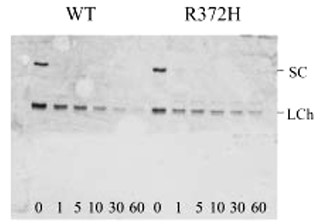Anti-Factor VIII Mouse Monoclonal Antibody – Library Pack (101101)
$548.00
SKU: 101101
Categories: Antibody Products, Coagulation Factor Antibodies, Library Packs, Products
Overview
Product Name Anti-Factor VIII Mouse Monoclonal Antibody - Library Pack (101101)
Description Anti-Factor VIII Mouse Monoclonal Antibody Library Pack - Includes 100 ug of each of the following antibodies:
10101 - Anti-Factor VIII Mouse Monoclonal Antibody - Clone F82.2.9 - Isotype IgG1
10102 - Anti-Factor VIII Mouse Monoclonal Antibody - Clone F82.2.32 - Isotype IgG1
10103 - Anti-Factor VIII Mouse Monoclonal Antibody - Clone F85.5.72 - Isotype IgG1
10104 - Anti-Factor VIII Mouse Monoclonal Antibody - Clone F827.4 - Isotype IgG2a
10101 - Anti-Factor VIII Mouse Monoclonal Antibody - Clone F82.2.9 - Isotype IgG1
10102 - Anti-Factor VIII Mouse Monoclonal Antibody - Clone F82.2.32 - Isotype IgG1
10103 - Anti-Factor VIII Mouse Monoclonal Antibody - Clone F85.5.72 - Isotype IgG1
10104 - Anti-Factor VIII Mouse Monoclonal Antibody - Clone F827.4 - Isotype IgG2a
Target Factor VIII
Species Reactivity Human
Applications WB,ELISA
Host Mouse
Clonality Monoclonal
Immunogen Purified human Factor VIII.
Associated Products This library pack includes the following antibodies:
10101 - Anti-Factor VIII Antibody - Clone F82.2.9 - Isotype IgG1
10102 - Anti-Factor VIII Antibody - Clone F82.2.32 - Isotype IgG1
10103 - Anti-Factor VIII Antibody - Clone F85.5.72 - Isotype IgG1
10104 - Anti-Factor VIII Antibody - Clone F827.4 - Isotype IgG2a
10101 - Anti-Factor VIII Antibody - Clone F82.2.9 - Isotype IgG1
10102 - Anti-Factor VIII Antibody - Clone F82.2.32 - Isotype IgG1
10103 - Anti-Factor VIII Antibody - Clone F85.5.72 - Isotype IgG1
10104 - Anti-Factor VIII Antibody - Clone F827.4 - Isotype IgG2a
Properties
Form Liquid
Concentration Lot Specific
Formulation PBS, pH 7.4.
Buffer Formulation Phosphate Buffered Saline
Buffer pH pH 7.4
Format Purified
Purification Purified by Protein G affinity chromatography
Specificity Information
Specificity 10101, 10102, and 10103 recognize full-length human Factor VIII (epitopes not determined). 10104 recognizes an epitope at the N-terminal region of the 83kDa light chain of Factor VIII. These antibodies do not cross-react with von Willebrand factor.
Target Name Coagulation factor VIII
Target ID Factor VIII
Uniprot ID P00451
Gene Name F8
Gene ID 300841
Sequence Location Secreted, extracellular space.
Biological Function Factor VIII, along with calcium and phospholipid, acts as a cofactor for F9/factor IXa when it converts F10/factor X to the activated form, factor Xa.
Research Areas Coagulation factors.
Background Factor VIII (FVIII) is an essential blood-clotting protein, also known as anti-hemophilic factor (AHF). In humans, factor VIII is encoded by the F8 gene. Defects in this gene result in hemophilia A, a recessive X-linked coagulation disorder. Factor VIII is produced in liver sinusoidal cells and endothelial cells outside of the liver throughout the body. This protein circulates in the bloodstream in an inactive form, bound to another molecule called von Willebrand factor, until an injury that damages blood vessels occurs. In response to injury, factor VIII is activated and separates from von Willebrand factor. The active protein (sometimes written as factor VIIIa) interacts with another coagulation factor called factor IX. This interaction sets off a chain of additional chemical reactions that form a blood clot.
Application Images


Description #10104 Detection of Factor VIII light chain (LCh) in wild-type (WT) and recombinant (R372H) Factor VIII after reaction with thrombin over time (Nogami et al. 2005 Blood 105: 4362-4368).
Handling
Storage These antibodies are stable for at least one (1) year at -20°C to -70°C. Store product in appropriate aliquots to avoid multiple freeze-thaw cycles.
Dilution Instructions Dilute in PBS or medium that is identical to that used in the assay system.
Application Instructions These antibodies have been qualified for use in ELISA and immunoblotting to detect human Factor VIII.
References & Data Sheet
References Takeyama M et al. (2012) Biochemistry 51: 820-828.
Nogami K et al. (2005) Blood 105: 4362-4368.
Fay PJ et al. (2001) J Biol Chem 276: 12434-12439.
Fay PJ (1988) Arch Biochem Biophys 262: 525-531.
Fay PJ et al. (1986) Biochim Biophys Acta 87: 268-278.
Nogami K et al. (2005) Blood 105: 4362-4368.
Fay PJ et al. (2001) J Biol Chem 276: 12434-12439.
Fay PJ (1988) Arch Biochem Biophys 262: 525-531.
Fay PJ et al. (1986) Biochim Biophys Acta 87: 268-278.
Data Sheet  Download PDF Data Sheet
Download PDF Data Sheet
 Download PDF Data Sheet
Download PDF Data Sheet


